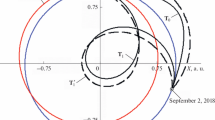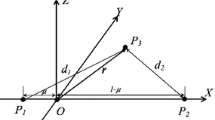Abstract
A parametric variational principle and the corresponding numerical algorithm are proposed to solve a linear-quadratic (LQ) optimal control problem with control inequality constraints. Based on the parametric variational principle, this control problem is transformed into a set of Hamiltonian canonical equations coupled with the linear complementarity equations, which are solved by a linear complementarity solver in the discrete-time domain. The costate variable information is also evaluated by the proposed method. The parametric variational algorithm proposed in this paper is suitable for both time-invariant and time-varying systems. Two numerical examples are used to test the validity of the proposed method. The proposed algorithm is used to astrodynamics to solve a practical optimal control problem for rendezvousing spacecrafts with a finite low thrust. The numerical simulations show that the parametric variational algorithm is effective for LQ optimal control problems with control inequality constraints.
Similar content being viewed by others
References
Kojima, A. and Morari, M. LQ control for constrained continuous-time systems. Automatica, 40, 1143–1155 (2004)
Bemporad, A., Borrelli, F., and Morari, M. Model predictive control based on linear programming-the explicit solution. IEEE Transactions on Automatic Control, 47, 1974–1985 (2002)
Bemporad, A., Morari, M., Dua, V., and Pistikopoulos, E. N. The explicit linear quadratic regulator for constrained systems. Automatica, 38, 3–20 (2002)
Goebel, R. and Subbotin, M. Continuous time linear quadratic regulator with control constraints via convex duality. IEEE Transactions on Automatic Control, 52, 886–892 (2007)
Betts, J. T. Survey of numerical methods for trajectory optimization. Journal of Guidance, Control, and Dynamics, 21, 193–207 (1998)
Betts, J. T. Practical Methods for Optimal Control Using Nonlinear Programming, Society for Industrial and Applied Mathematics, Philadelphia (2001)
Hull, D. G. Initial lagrange multipliers for the shooting method. Journal of Guidance, Control, and Dynamics, 31, 1490–1492 (2008)
Lenz, S. M., Bock, H. G., Schlöder, J. P., Kostina, E. A., Gienger, G., and Ziegler, G. Multiple shooting method for initial satellite orbit determination. Journal of Guidance, Control, and Dynamics, 33, 1334–1346 (2010)
Benson, D. A., Huntington, G. T., Thorvaldsen, T. P., and Rao, A. V. Direct trajectory optimization and costate estimation via an orthogonal collocation method. Journal of Guidance, Control, and Dynamics, 29, 1435–1440 (2006)
Hull, D. G. Conversion of optimal control problems into parameter optimization problems. Journal of Guidance, Control, and Dynamics, 20, 57–60 (1997)
Biegler, L. T. Nonlinear Programming: Concepts, Algorithms, and Applications to Chemical Processes, Society for Industrial and Applied Mathematics, Philadelphia (2010)
Margraves, C. R. and Paris, S. W. Direct trajectory optimization using nonlinear programming and collocation. Journal of Guidance, Control, and Dynamics, 10, 338–342 (1987)
Tang, S. and Conway, B. A. Optimization of low-thrust interplanetary trajectories using collocation and nonlinear programming. Journal of Guidance, Control, and Dynamics, 18, 599–604 (1995)
Fahroo, F. and Ross, I. M. Costate estimation by a Legendre pseudospectral method. Journal of Guidance, Control, and Dynamics, 24, 270–277 (2001)
Gong, Q., Ross, I. M., and Fahroo, F. Costate computation by a Chebyshev pseudospectral method. Journal of Guidance, Control, and Dynamics, 33, 623–628 (2010)
Warner, M. S. and Hodges, D. H. Solving optimal control problems using hp-version finite elements in time. Journal of Guidance, Control, and Dynamics, 23, 86–94 (2000)
Estep, D. J., Hodges, D. H., and Warner, M. The solution of a launch vehicle trajectory problem by an adaptive finite-element method. Computer Methods in Applied Mechanics and Engineering, 190, 4677–4690 (2001)
Zhong, W. X. and Zhang, R. L. Parametric variational principles and their quadratic programming solutions in plasticity. Computers and Structures, 30, 887–896 (1988)
Darby, C. L., Hager, W. W., and Rao, A. V. Direct trajectory optimization using a variable low-order adaptive pseudospectral method. Journal of Spacecraft and Rockets, 48, 433–445 (2011)
Darby, C. L., Hager, W. W., and Rao, A. V. An hp-adaptive pseudospectral method for solving optimal control problems. Optimal Control Applications and Methods, 32, 476–502 (2011)
Ross, I. M. and Fahroo, F. Pseudospectral knotting methods for solving optimal control problems. Journal of Guidance, Control, and Dynamics, 27, 397–405 (2004)
Gong, Q., Fahroo, F., and Ross, I. M. Spectral algorithm for pseudospectral methods in optimal control. Journal of Guidance, Control, and Dynamics, 31, 460–471 (2008)
Guo, T., Jiang, F. H., and Li, J. F. Homotopic approach and pseudospectral method applied jointly to low thrust trajectory optimization. Acta Astronautica, 71, 38–50 (2012)
Fahroo, F. and Ross, I. M. Advances in pseudospectral methods for optimal control. AIAA Guidance, Navigation and Control Conference, AIAA 2008-7309, Hawaii (2008)
Ding, H. L., Yang, B. E., Lou, M., and Fang, H. F. New numerical method for two-dimensional partially wrinkled membranes. AIAA Journal, 41, 125–132 (2003)
Zhang, H. W., Wang, H., and Wang, J. B. Parametric variational principle based elastic-plastic analysis of materials with polygonal and Voronoi cell finite element methods. Finite Elements in Analysis and Design, 43, 206–217 (2007)
Billups, A. C. and Murty, K. C. Complementarity problems. Journal of Computational and Applied Mathematics, 124, 303–318 (2000)
Wright, S. J. Primal-Dual Interior-Point Methods, Society for Industrial and Applied Mathematics, Philadelphia (1997)
Wen, H., Jin, D. P., and Hu, H. Y. Costate estimation for dynamic systems of the second order. Science in China Series E: Technological Sciences, 52, 752–760 (2009)
Iserles, A. and Nørsett, S. P. On the solution of linear differential equations in Lie groups. Philosophical Transactions of the Royal Society A, 357, 983–1019 (1999)
Hairer, E., Lubich, C., and Wanner, G. Geometric Numerical Integration: Structure-Preserving Algorithms for Ordinary Differential Equations, Springer, Berlin (2002)
Rao, A. V., Benson, D. A., and Darby, C. GPOPS, a MATLAB software for solving multiplephase optimal control problems using the Gauss pseudospectral method. ACM Transactions on Mathematical Software, 37, 1–39 (2010)
Bless, R. R. and Hodges, D. H. Finite element solution of optimal control problems with statecontrol inequality constraints. Journal of Guidance, Control, and Dynamics, 15, 1029–1032 (1992)
Warner, M. S. and Hodges, D. H. Treatment of control constraints in finite element solution of optimal control problems. Journal of Guidance, Control, and Dynamics, 22, 358–360 (1999)
Clohessy, W. H. and Wiltshire, R. S. Terminal guidance for satellite rendezvous. Journal of the Aerospace Sciences, 27, 653–658 (1960)
Lawden, D. F. Optimal Trajectories for Space Navigation, Butterworths, London (1963)
Kulkarni, J. E., Campbell, M. E., and Dullerud, G. E. Stabilization of spacecraft flight in Halo orbits: an H∞ approach. IEEE Transactions on Control Systems Technology, 14, 572–578 (2006)
Author information
Authors and Affiliations
Corresponding author
Additional information
Project supported by the National Natural Science Foundation of China (Nos. 11102031 and 11272076), the Fundamental Research Funds for Central Universities (No.DUT13LK25), the Key Laboratory Fund of Liaoning Province (No. L2013015), the China Postdoctoral Science Foundation (No. 2014M550155), and the State Key Laboratory of Mechanics and Control of Mechanical Structures (Nanjing University of Aeronautics and Astronautics) (No.MCMS-0114G02)
Rights and permissions
About this article
Cite this article
Peng, Hj., Gao, Q., Zhang, Hw. et al. Parametric variational solution of linear-quadratic optimal control problems with control inequality constraints. Appl. Math. Mech.-Engl. Ed. 35, 1079–1098 (2014). https://doi.org/10.1007/s10483-014-1858-6
Received:
Revised:
Published:
Issue Date:
DOI: https://doi.org/10.1007/s10483-014-1858-6
Key words
- parametric variational principle
- optimal control
- inequality constraint, linear complementarity
- astrodynamics
- linear-quadratic (LQ)




